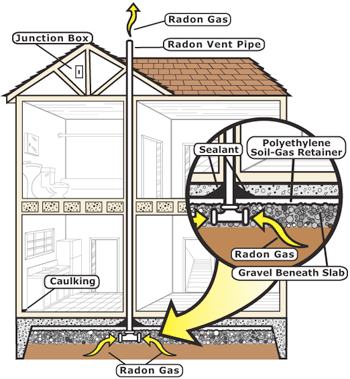Share
Related Topics
Tagged As
When building a new home, there are certainly many considerations to take into account. These can include anything from roofing to the HVAC system to the light fixtures you plan to install. While you are starting your list of must-have’s in your new home, make sure health is a priority.
We do not strictly control Google ad content. If you believe any Google ad is inappropriate, please email us directly here.
Installing a passive system during construction to exhaust radon gas can save a lot of money in the long run. Most sources estimate prevention techniques will cost only $250 to $750 during home construction, but will cost $1200 to $2000 after construction is complete. If you have hired a contractor to build your home, ask if he/she can incorporate these passive radon-resistant measures into the home design.
Radon Resistant New Construction (RRNW)
How It Works
In RRNW, a passive system is installed that uses what’s called a “ passive stack effect” to move air from below the house up through a vent pipe to the roof where it is expelled. A passive system for removing radon gases is usually compromised of these four components.
- Gravel or Aggregate Layer - This is a gas permeable layer that goes under the concrete slab or flooring. This allows radon to move freely into the vent pipe.
- Gas Retarder Layer - This layer of vapor retarder (usually a plastic-type sheeting) goes above the aggregate layer to prevent gases from entering
 the home.
the home.
- Vent Pipe - This PVC pipe goes from the aggregate layer up through the home to exhaust radon through the roof - minimum of 3 inches in width.
- Caulk or Sealant - This is used to fill in cracks in the foundation and walls to prevent radon gas from entering.
In addition, you’ll want to make sure your attic has an electrical junction box so that an active system can be installed there later if needed. An active system uses an inline fan to remove the radon-filled air from the soil below a home. After your new home is constructed, you’ll want to test for radon inside your home and determine if an active radon removal system is necessary. If the radon action level is above 4 PicoCuries per liter (PCi/L), an active system is recommended. (Other measures can also help remove radon from your home, such as balanced mechanical ventilation systems.)
References:
http://www.ct.gov/dph/cwp/view.asp?a=3140&q=387610
http://www.michigan.gov/deq/0,1607,7-135-3310_4105_4196-10570--,00.html
http://www.health.ny.gov/environmental/radiological/radon/rrnc/general.htm
http://www.buildingscience.com/documents/information-sheets/soil-gas-control/?searchterm=radon
Photo Credit: Environmental Protection Agency
HHI Error Correction Policy
HHI is committed to accuracy of content and correcting information that is incomplete or inaccurate. With our broad scope of coverage of healthful indoor environments, and desire to rapidly publish info to benefit the community, mistakes are inevitable. HHI has established an error correction policy to welcome corrections or enhancements to our information. Please help us improve the quality of our content by contacting allen@healthyhouseinstitute.com with corrections or suggestions for improvement. Each contact will receive a respectful reply.
The Healthy House Institute (HHI), a for-profit educational LLC, provides the information on HealthyHouseInstitute.com as a free service to the public. The intent is to disseminate accurate, verified and science-based information on creating healthy home environments.
While an effort is made to ensure the quality of the content and credibility of sources listed on this site, HHI provides no warranty - expressed or implied - and assumes no legal liability for the accuracy, completeness, or usefulness of any information, product or process disclosed on or in conjunction with the site. The views and opinions of the authors or originators expressed herein do not necessarily state or reflect those of HHI: its principals, executives, Board members, advisors or affiliates.








